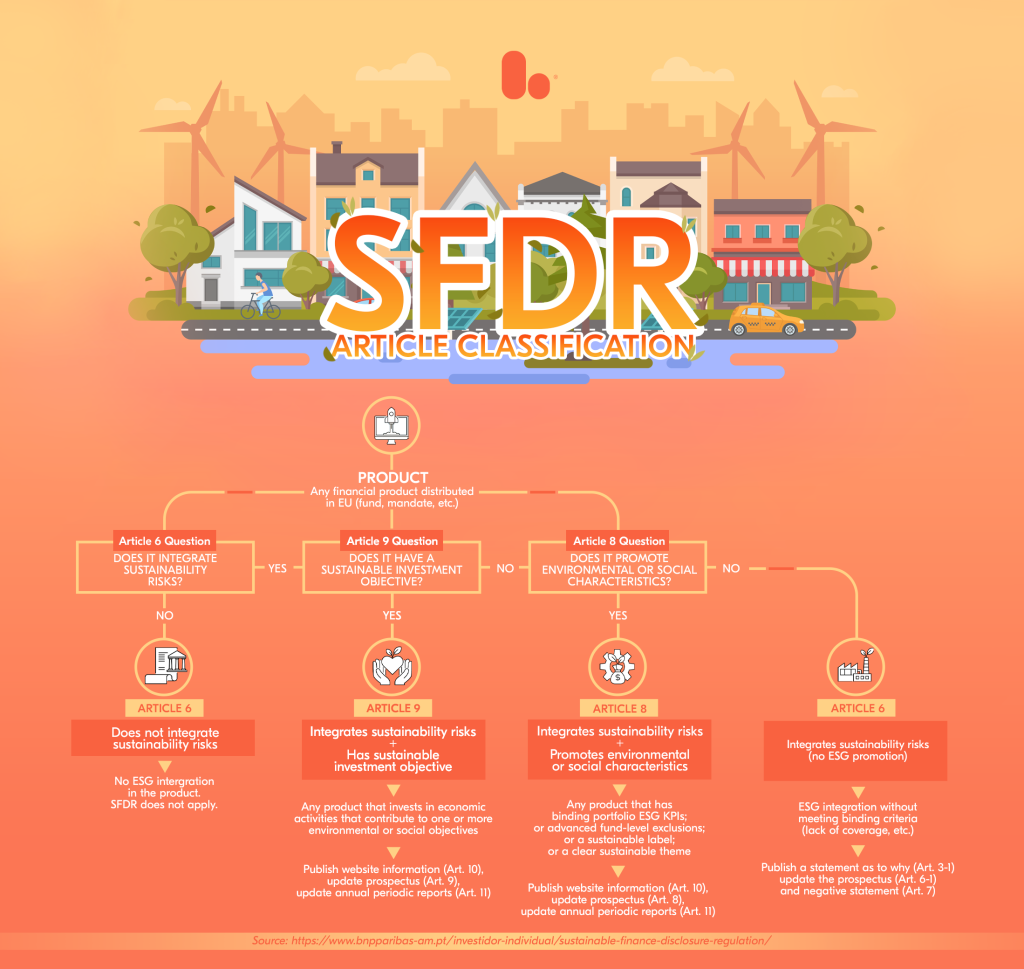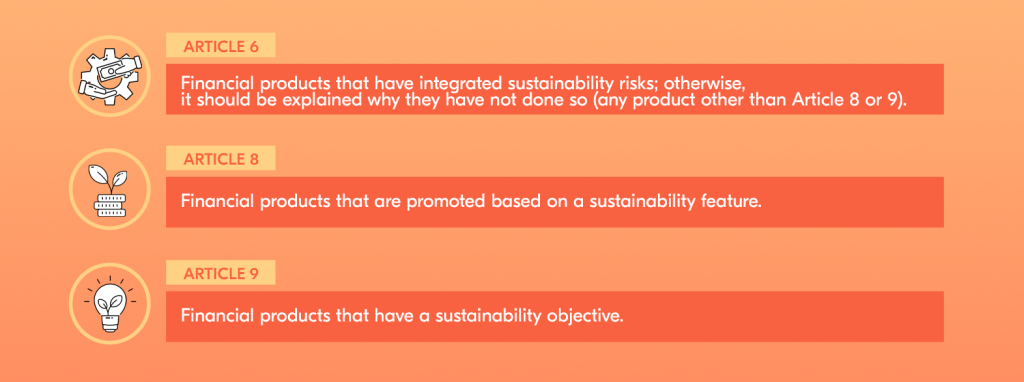ESG Updates for 2023
DISCLAIMER: This post was last modified on 30 January 2023. Some information in this article may not be updated.
The Sustainable Finance Action Plan establishes a framework regulation in the EU (European Union) for the financial services and investment management sector to facilitate and accelerate the flow of capital from private investors to sustainable projects and businesses.
Each part of the regulation is intended to make it easier for capital to flow to projects and companies whose activities help the transition to a greener economy.
Under these rules, the European Commission (EC) requires detailed information from financial market participants about how they tackle and reduce any possible negative impacts that their investments may have on the environment and society in general, strengthening investor protection, reducing greenwashing and “ultimately supporting the financial system’s transition towards a more sustainable economy.”
Here is a general overview of the legal obligations under the new sustainability regulations and the upcoming obligations for 2023:
The Sustainable Finance Disclosure Regulation (SFDR)
The European Commission first required financial products to report on ESG (Environmental, Social and Governance) matters under the Sustainable Finance Disclosure Regulation (SFDR) requiring that all products, as a baseline requirement, should integrate sustainability risks into investment decisions. It came into force on 9 December 2019.

The first set of disclosure requirements was applied on 10 March 2021. However, little detail was given about what should be included. This is known as “level 1” disclosure at entity-level, which includes the identification, prioritisation and description of major adverse sustainability impacts and the measures considered or adapted.
On 6 April 2022, the EU Commission adopted the Regulatory Technical Standards (RTS) under “level 2” for the SFDR to complement the provisions of the Disclosure Regulation. This is accomplished by providing detailed guidance on disclosures relating to principal adverse impacts (PAIs) on sustainability factors for the Financial Market Participants (FMPs). It also involves the pre-contractual, periodic and website disclosures of financial products promoting environmental or social characteristics (“Art. 8 SFDR Products”) or having sustainable investment as their objective (“Art. 9 SFDR Products”).

FMPs will need to publish their first detailed entity-level PAI statement by 30 June 2023, as specified by the RTS. That first PAI statement would need to cover the first reference period from 1 January 2022 to 31 December 2022, which means that FMPs will need to start gathering relevant data from 1 January 2022. Financial products are then required to make pre-contractual and periodic disclosures on product-level PAI consideration— a disclosure to be published yearly.
The Taxonomy Regulation (TR)
The Taxonomy Regulation (TR) came into force on 12 July 2020. It establishes a set of criteria to determine whether an economic activity qualifies as environmentally sustainable and to establish the degree to which an investment is environmentally sustainable. It is supplemented by delegated acts containing technical screening criteria.
The TR establishes the following as environmental objectives: (1) climate change mitigation, (2) climate change adaptation, (3) sustainable use and protection of water and marine resources, (4) transition to a circular economy, (5) pollution prevention and control and (6) protection and restoration of biodiversity and ecosystems. The disclosure in relation to the last 4 objectives will be mandatory by 1 January 2023.
The first delegated act on sustainable activities for climate change adaptation and mitigation was published on 9 December 2021 and is applicable since January 2022. The act requires to include in the non-financial statement or consolidated non-financial statement the information on how and to what extent activities are associated with economic activities that qualify as environmentally sustainable under the TR.
A Complementary Climate Delegated Act was adopted in July 2022 which includes specific nuclear and gas energy activities, under strict conditions, in the list of economic activities and will apply from 1 January 2023.
Corporate Sustainability Reporting Directive (CSRD)
On 21 April 2021, in the wake of the EU Green Deal, the European Commission adopted a proposal for a Corporate Sustainability Reporting Directive (CSRD) aimed at revising and strengthening rules introduced by the existing Non-Financial Reporting Directive (NFRD). The CSRD was published in the Official Journal of the EU on 16 December 2022, having been formally adopted by the European Parliament and Council of the European Union in November.
The CSRD will require more detailed reporting requirements and ensures that large companies and listed small and mid-size enterprises (SMEs) are required to report on sustainability matters such as environmental rights, social rights, human rights and governance factors under the EU Sustainability Reporting Standards (“ESRS”) that are being developed by the European Financial Reporting Advisory Group (EFRAG). A first draft was composed and is intended to adopt the final standards by June 2023.
The CSRD would ensure alignment with other EU initiatives on sustainable finance (e.g., SFDR and TR).
The new sustainability reporting requirements will apply progressively from 2024–2028 to different categories of companies— in 2025, large and listed companies with more than 500 employees; in 2026, all large companies with more than 250 employees and a 40-million-euro turnover; and in 2027, all companies listed on regulated markets. The rules also apply to listed SMEs (they can be exempted from the application of the directive until 2028). Non-EU parent companies will also have to comply if they have an EU-established large subsidiary, a listed SME subsidiary, or a large EU branch.
The CSRD aims to ensure that companies report the information needed by investors and other financial market participants subject to the Disclosure Regulation. Specifically, that means that the reporting standards include indicators that would correspond to the indicators contained in the SFDR.
As final conclusions:
- Harmonization of regulation: The TR works as a tool to acquire additional information on climate change, as a guide to help the SFDR identify “green” products. The CSRD would include indicators that correspond to the indicators contained in the SFDR and ensures alignment with other EU initiatives on sustainable finance, such as the TR.
- FMPs should be aware of the requirements of the local supervisor: The regulations are in the process of being incorporated in each country, but some local supervisors have already established the procedures and forms to comply with the obligations.
- The SFDR includes a requirement for financial market participants to include disclosure information at the pre-contract stage: Disclosures should include reference to historical data, up to the last five periods. For instance, disclosures made in 2028 should include historical data from all reports, starting from the first disclosure in 2023.
- It is important to take into consideration that this regulation seeks to ensure that every product that has been placed on the market as ‘sustainable,’ must be transparent about how sustainability features are implemented.
- The CSRD attempts to standardise criteria: The directive reduces the complexity and the potential for duplicative reporting requirements, provides useful guidance on how to address ESG issues, and identifies both risks and opportunities that are relevant to your organisation and should be addressed in both ESG strategy and reporting. We recommend you learn and understand the new requirements under CSRD and the EU ESRS.
Here is a list of templates for reporting according to the SFDR, depending on the product classification:
- Annex 1 must be included in the disclosure, and the regulation document goes through the section requirements one by one.
- Annex 2 provides the template for pre-contractual disclosure for the financial products referred to in Article 8.
- Annex 3 is the template for outlining the sustainable development objective of disclosure for the financial products referred to in Article 9.
- Annex 4 is the template for giving information on the environmental and/or social characteristics of the investment/product referred to in Article 6 and Article 8.
- Annex 5 is the template for detailing sustainable development objectives of the investment/product referred to in Article 9.
For any questions or further assistance, contact Bolder Group’s Head of Corporate Luxembourg nicolas.charbonnet@boldergroup.com, Head of Governance Netherlands amber.dehaer@boldergroup.com or our ESG Specialist ana.prada@boldergroup.com.
Bolder Group does not provide financial, tax or legal advice and the information contained herein is meant for general information purposes only. We strongly recommend that before acting on any of the information contained herein, readers should consult with their professional advisers. The Bolder Group accepts no liability for any errors or omissions in the information, or the consequences resulting from any action taken by a reader based on the information provided herein.
Bolder Group refers to the global network of independent subsidiaries of Bolder Group Holding BV. Bolder Group Holding BV provides no client services. Such services are provided solely by the independent companies within the Bolder Group which are each legally distinct and separate entities and have no authority (actual, apparent, implied or otherwise) to obligate or bind Bolder Group Holding BV in any manner whatsoever. The operations of the Bolder Group are conducted independently and have no affiliation with third party financial, tax or legal advisory firms or corporations.
